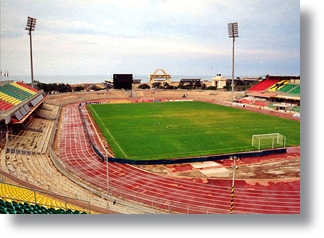Accra Sports Stadium: What's in a Name?

 |
| Ohene Djan Stadium |
The Kumasi Sports Stadium, Ghana’s largest, on Asante ethnic land and re-named Baba Yara (a non-Asante from one of the northern ethnic groups) in 2008, has not experienced the AMA attitude, that the Baba Yara Sports Stadium should be re-named Kumasi Sports Stadium because it is on Asante land. The Kumasi Metropolitan Assembly (KMA) sees Baba Yara in larger historical framework: Baba Yara, a soccer legend, whether a non-Asante or not, contributed immensely to Ghana’s soccer development as opposed to the northern ethnic groups where he came from.
The Accra Sports Stadium is on Ga ethnic land but it was built with Ghanaians tax money. Legally, the land today is government property. That makes it, like any other Ghana-government-owned national stadium for that matter, a pan-Ghanaian edifice. Ghanaians, therefore, have the right, both legally and culturally, to name it after any Ghanaian they deem fit.
While the NPP’s re-naming of the Accra Sports Stadium as Ohene Djan Stadium was purely on patriotism, AMA’s stand is condescendingly on tribalism. That’s African tribalistic logic at play as seen in Somalia, where for the past 22 years, poorly thinking clans/tribes have collapsed their country and visited indescribable hardship on Somalians.
AMA’s stand is dangerous. It reveals that Ghanaians’ deep cultural concerns, 50 years after self-rule from European colonialism, aren’t heavily factored in when certain national endeavours are being undertaken. Of profound interest is the enlightening argument raised by the Aburihene, Otubour Gyan Kwasi II, when he spoke to Asempa News:
“The AMA re-naming of the stadium on the basis that it has no leaning with Ga culture and customs was unfortunate, reminding the assembly that the land being occupied by Gas was given to them by the Akwapims and the people of Aburi when they first came from Ile Ifeh in Nigeria … the Tetteh Quarshie Memorial Hospital in Akwapim named after a Ga and the Komfo Anokye Teaching Hospital in Kumasi among others,” he said.
The Aburi Traditional Council position is pan-Ghana, more nationalistic and educational than ethnic. All the 56 ethnic groups that form Ghana are simultaneously migrants who are constantly mixing and come from the same cultural family. The slight differences are geographic. Rumoko Rashidi, the activist African-American historian and author of Introduction to the Study of African Classical Civilizations (1993), would explain to the Ga and Aburi Traditiional Council that “History is a light that illuminates the past and a key that unlocks the door to the future.”
History lessons and a dialogue between Otubour Gyan Kwasi II, the Aburi Traditional Council and AMA will be superbly good for Ghana and Africa. As the Tshwane, South Africa-based Institute for Security Studies (ISS) would say, knowledge will empower the Aburi Traditional Council, AMA and Africa.
I had a long chat with Canada’s Carleton University political scientist Daniel Tetteh Osabu-Kle, himself a Ga. Osabu-Kle explained that since all Africans practically have the same cultural roots, it is possible to create a cultural symbol drawn from all the African ethnic groups and use it as both national and continental unifier and stimulant for larger African development.
I can use myself to illustrate Osabu-Kle. Though I am an Asante, I am told by my maternal elders that over 100 years ago, our family migrated from the present Denkyira area, which is now part of modern Ghana’s Western Region. My paternal family, too, is said to have come to the present Asante land from the Nzema ethnic group, which is in Ghana’s Western Region. At a subterranean ethnic mix, my paternal grandfather, Opanin Kweku Akosah, a wealthy high cross-ethnic polygamist, married from good number of Ghanaian ethnic groups: Ewe, Asante, Ga, Akuapim, Akyem, Brong, Fante, Dagomba and Ahafo. Opanin Akosah was easily able to marry from these Ghanaian ethnic groups simply because he found his Asante culture and other ethnic groups’ practically the same. Fruitfully, he had over 60 children with his wives. And my grandfather’s children are examples of Osabu-Kle’s hypothesis.
Issues like these help thinking and clear some of the entangling tribal cobwebs in the African brain. You never know how deeply you can think till you are involved in some pressing controversies. But the controversy should be driven by facts and civility despite various jaundiced opinions expressed, some bordering on misplaced emotions than evidence.
If hard facts are to drive the re-naming of Accra Sports Stadium, and we are to avoid fatal controversies, we ought to draw from Benford's Law of Controversy, as articulated by science-fiction writer Gregory Benford in 1980. It states that “Passion is inversely proportional to the amount of real (true) information available. In other words, the fewer facts are known to and agreed on by the participants, the more controversy there is, and the more is known the less controversy there is.”
Are the Akwapim facts weightier than the Ga facts or the other way round? Which of the two ethnic groups’ facts will settle the dispute and engender less controversy? Or should the two facts merge to create less controversy? That will be very African and all-encompassing proposition.
Granted that various African ethnic groups (some incompatible) were brought together against their will by colonialism, Benford's Law would infer that controversy is expected in modern African nation-states make-up from scratch. African communities such as the Ga and the Aburi-Akwapim must frequently decide on courses of action based on insufficient information as a result of the many unrealistic national public policies running African nation-states.
The cultures driving the over 2,000 African ethnic groups are practically the same (holding geography constant) and could be skillfully appropriated to resolve the Ga-Aburi-Akwapim stadium naming controversy. For the larger progress of Ghana, all the 56 ethnic groups that form Ghana may need each other more than any of them may envisage. AMA’s thinking might help all Ghanaians to look clearly at the whole ethnic issue both culturally, morally and intellectually.
